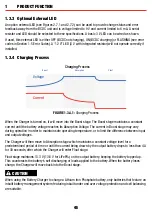
14
5
FCC DECLARATION
This device complies with part 15 of the FCC Rules. Operation is subject to the following two conditions: (1) This device may not
cause harmful interference, and (2) this device must accept any interference received, including interference that may cause
undesired operation.
Note: This equipment has been tested and found to comply with the limits for a Class B digital device, pursuant to part 15 of the
FCC Rules. These limits are designed to provide reasonable protection against harmful interference in a residential installation.
This equipment generates, uses and can radiate radio frequency energy and, if not installed and used in accordance with the
instructions, may cause harmful interference to radio communications. However, there is no guarantee that interference will not
occur in a particular installation. If this equipment does cause harmful interference to radio or television reception, which can be
determined by turning the equipment off and on, the user is encouraged to try to correct the interference by one or more of the
following measures:
• Reorient or relocate the receiving antenna.
• Increase the separation between the equipment and receiver.
• Connect the equipment into an outlet on a circuit different from that to which the receiver is connected.
• Consult the dealer or an experienced radio/TV technician for help.
6
FREQUENTLY ASKED QUESTIONS
Q
The BCDC turns ON at 12.9 V (12 V) and OFF at 12.7 V (11.9 V), but you say it operates down to 9 V, explain?
A
The BCDC will turn OFF for a split second every 100 seconds to measure the unloaded voltage at the battery. When the
BCDC turns off it is not drawing any load from the start battery, no load means that there is no voltage drop over the cable
run. This allows the BCDC to measure the actual battery voltage, or the voltage at the battery. If this actual battery voltage
is below 12.7 V (11.9 V), the BCDC will turn OFF. At any other time during the charging process, if the voltage at the BCDC
drops below 9 V the BCDC will turn OFF.
Q
How does the BCDC charge an Auxiliary battery at 14 V when it only gets 9 V in?
A
The BCDC can act as both a reducer and a booster, so it can operate from a voltage of above, equal to or below the desired
output voltage. The unit is also microprocessor controlled allowing it to output a REDARC proprietary charging algorithm
independent of the input. This allows the unit to charge specific to the battery type even if the input voltage is low due to
voltage drop.
Q
Where should I mount the BCDC Unit?
A
The BCDC should be mounted as close as possible to the battery being charged (generally called the Auxiliary or House
battery). If the Auxiliary battery is located under the bonnet, pick a location for the BCDC that is close to the battery
and away from any direct engine heat. If the BCDC is to be mounted into a Caravan or Camper, near or in the battery
compartment is generally the best position. It is also a good idea to mount the BCDC to a metal surface if possible, to
ensure optimal heat dissipation, though this is not crucial.
Q
What does the charger do if the temperature around it rises above its operating temperature?
A
As the temperature of the BCDC rises above a certain level the current capacity of the output is decreased gradually in
order to protect both the battery and the BCDC unit.
Q
If I use the BCDC to charge my auxiliary battery do I still need to install a battery isolator?
A
The BCDC incorporates the functionality of a battery isolator, it will turn ON and start charging when it senses that the
vehicle has started and similarly it will turn OFF when the vehicle is turned OFF.
Q
I’ve heard that you shouldn’t charge 2 batteries of different chemistries from the same source, will I have any problems
charging my AGM or Gel auxiliary battery from my Lead Acid start battery?
A
The BCDC does not ‘link’ the batteries together like a battery isolator does, it is a DC-DC battery charger. The output
from the unit is tailored specifically to the selected output battery type, and therefore allows the optimal charging of the
auxiliary battery, no matter what chemistry your start battery is.
Q
My BCDC is setup for 12 V Alternator input but will not start when the vehicle is turned On, I’ve followed the trouble shooting
guide and the setup is fine, what’s the problem?
A
The most likely cause of this issue is that the BCDC is somehow ‘stuck’ in 24 V mode. Try removing the ‘Vehicle’ (RED) wire
and reconnecting it. If the problem still exists please contact REDARC Corporation.


































